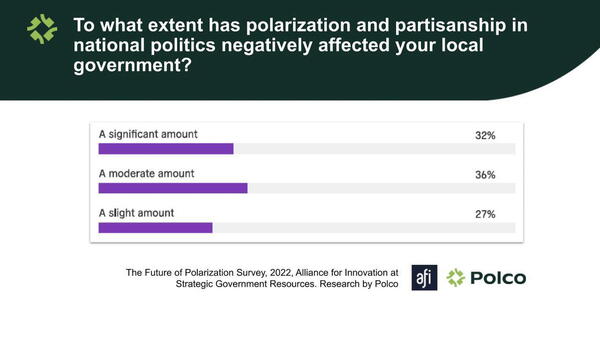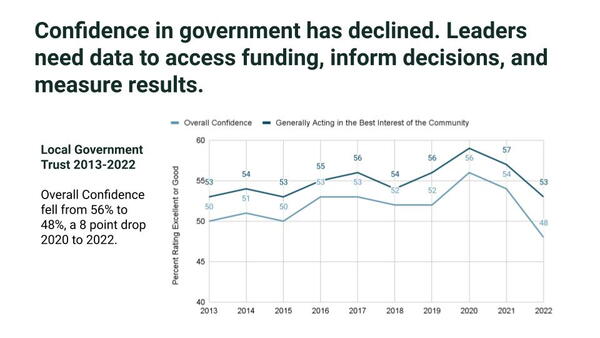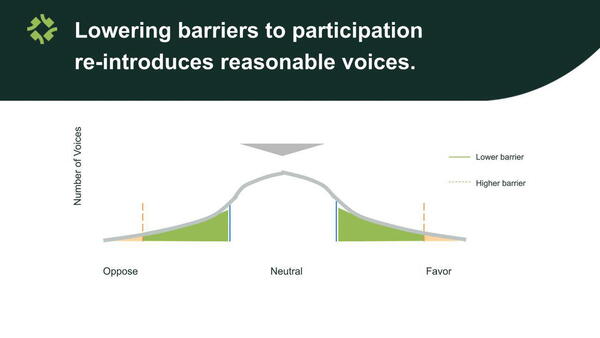
These days we see polarization pollute political discourse and lead to dwindling trust in local government. Nearly 70% of government officials say political division negatively impacts their organization, according to a recent Polco survey investigating polarization at the community level.
“As much as local governments intend to be apolitical, the impact of the national divide is now hitting home locally,” said Michelle Kobayashi, Polco vice president of innovation. Kobayashi, who designed the assessment, is a thought-leading survey scientist and has helped governments make sense of public opinion for the last 30 years.
Many government employees think the fracture will likely worsen in the near future. Luckily, polarization may not be as pervasive as Twitter threads may have us believe. And some organizations have already implemented strategies like education and collaboration to help regain lost trust and temper divisiveness.
How Misinformation Fuels Polarization
As communication technology continues to advance, ideas and information—and misinformation—spread further and faster than ever before. “The past few election cycles have shown pretty vividly how social media can be used to amplify misinformation and disinformation in state and federal elections,” said Josh Brockway, senior strategic foresight strategist for Strategic Government Resources (SGR). SGR partnered with Polco to conduct the polarization assessment survey. “We [wanted] to see if misinformation and disinformation were making their way down to the local level,” he said. The survey results reveal that they are.
Almost 80% of local government professionals said misinformation has negatively affected their organization by a moderate to a significant amount. Only 7% said they have not witnessed any impact from misinformation. But polarized disruption comes from a small percentage of extreme voices.
“Many social media postings [include] disinformation that comes from a small but vocal minority of our citizens,” one government official stated in the survey. They added that their organization spends a significant amount of time rebutting falsehoods through their communications channels and at city council meetings.

However, traditional approaches to engagement are no longer enough to overcome oceans of fake news and extremism. Polco’s national public opinion database shows that only about 20% of Americans have ever attended a local government meeting. In-person city council meetings don’t reach the masses.
Plus, the decline in local journalism has also made messaging more difficult. Over 2,500, credentialed news outlets have vanished since 2005, constricting a long-standing mode of communication.
And yet, the demand and consumption of new media are at an all-time high. More people receive news from national mainstream sources (which are often more polarized) and social media (which often promotes more sensationalized or fabricated news).
Social media encourages more divisive behavior as well. Social media platforms promote confirmation bias; the algorithms satisfy personal tastes so that everyone online lives in their own bubble fed by cherry-picked information. The system reinforces closely held mindsets, leading to more tribalism and identity politics.
“Grandstanding online reduces cooperation and increases divisiveness,” Kobayashi said. “While bits of grandstanding have always been a part of public meetings in the past, social media has provided an opportunity for grandstanders to claim greater amounts of attention, providing them with a bigger microphone.”
On the other hand, Polco engagement experts observe the majority of Americans don’t share their perspectives about community issues online at all. “You really only see the more extreme viewpoints on social media,” said Angelica Wedell, Polco director of communications.
The decline of local news coupled with the rise of polarized social media dramatically altered the way Americans exchange information. And as a result, around 80% of government leaders don’t believe their community members are well-informed on public issues.
“Misinformation becomes a self-feeding cycle,” Wedell said. “Residents don’t get the most reliable information about their city and local government leaders don’t get the most reliable look at public opinion. And that becomes a problem if you’re trying to make policy decisions from reacting to social media comments.” She says local governments must turn to other engagement solutions for resident feedback, with sound methods and strategies to filter the noise.

Waning Trust and Other Impacts of Polarization on Local Government
But polarization is not all bad. Opposites help us define, identify, and balance two parties. It gives people choices. On the flip side, we’re witnessing the pitfalls of too much discord in real-time.
A recent study found that polarization leads to higher borrowing costs at the local level. It’s contributed to many government officials leaving the public sector, causing staffing issues. Polarization also creates funding issues and divisions among staff and elected officials. “Key decisions are often stalled out of no action,” one local government professional responded to the survey.
Other top impacts of polarization include council interactions (63%), resident hostility toward government employees (70%), and resident engagement with local government (70%). A decline in trust is the most-felt consequence (73%). However, it is still too early to know if the rate of decline will continue.
“At the federal level, public trust has been decreasing steadily for the past 30 years. Our national database on local government has not shown the downward spiral until around 2021 and 2022,” Kobayashi said. “We are not sure if this is simply a blip or if the local government trust trends will start to more closely mirror the national trends.”

Overcome Polarization at the Local Level with Education and Collaboration
Fortunately, some governments are already taking measures to overcome polarization. More than half (61%) of local government professionals believe their organizations play a role in combating political division.
“We interpreted that as ‘Yeah there’s a problem, but we’re not giving up. We still feel optimistic. We can do something about that,’” Brockway said.
Further, 24% of government officials surveyed have already implemented strategies to prevent polarization. Some respondents say their organizations are aiming for political balance on appointed boards. Others have hired diversity, equity, and inclusion strategists. Many say teaching digital literacy and education is their main defense.

Community leaders point to government-sponsored engagement and education as the key solution for misinformation-based polarization. For example, a number of cities (such as Celina, Texas) have launched citizen academies that teach civic education, youth leadership, and other classes. Brockway stresses that twenty-first century civic education needs to be much more than teaching the nuts and bolts of the federalist government. People need to learn true compromise and mediation skills.
Some governments are getting residents involved in the decision-making process itself. “We regularly host roundtable meetings,” one government employee said on the survey. “The purpose of these meetings is to jointly work to solve problems that deal with the service our local government provides to our constituents.”
Lowering barriers to participation is another effective strategy. Technology presents one of the best ways to reach more people at scale and connect with more diverse voices.
“Polarization is a symptom of imbalance. But inclusive, convenient opportunities for engagement even the scales,” Wedell said. “That’s why we like surveys so much. They leverage tech most people already use. They don’t have the same burdens as in-person meetings like time constraints, transportation, or taking away from care-taking responsibilities. So you wind up with a lot more people able to participate. And with the right methods, you get a much broader, representative range of residents.” She emphasized that the majority of residents express the more reasonable viewpoints. The reality is that most of the community is not so extremely opposite after all.
To go a step further, the best government actions are guided by reliable feedback. This may require letting go of some control. But including constituents in the decision-making process allows government officials to align their actions with community values. Listening and acting on feedback will also strengthen trust.
“When you share the power, it immediately disarms the cycle. It’s hard and it’s a little frightening, and you have to be very good at being humble and collaborative and negotiating and mediating these differences of opinion,” Brockway said. “But the benefits are incredible. When you work together, you have something both groups have bought into. You can start the virtuous cycle of working together because now you have a precedent.”

JESSIE O’BRIEN serves as the lead copywriter for Polco. Polco makes community engagement accurate and reliable. Hundreds of government leaders trust Polco for insights from surveys and data analytics on one easy-to-use online platform.
New, Reduced Membership Dues
A new, reduced dues rate is available for CAOs/ACAOs, along with additional discounts for those in smaller communities, has been implemented. Learn more and be sure to join or renew today!
